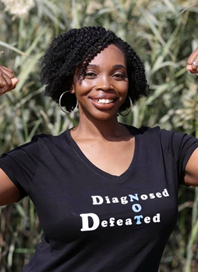At the beginning of 2020, I was living in the United Arab Emirates. By spring, I had moved to Martinique, a small French island in the Caribbean, just in time to celebrate their annual Carnival. I planned to settle there with my family for a while, learn French more fluently and begin a new chapter in my life. However, before the dust could settle on our Carnival masks and skirts, the COVID-19 pandemic had spread to France and we were on lockdown. It happened so quickly that I hadn’t even established care with an Endocrinologist yet.
France’s version of the lockdown was intense. We could only leave our homes for five approved reasons, apps were created to track our movements, helicopters routinely flew around the island ensuring that the beaches remained empty, and police officers issued fines to all those who violated the rules. I’ll admit that one day I was craving the chance to write on the beach and took the 502 steps from our front door to the beach and opened my laptop to write with my toes tucked into the sand. Within a few minutes, I found myself apologizing to three police officers for misunderstanding and quickly learned that staying off the beach extended beyond swimming.
During lockdown, when international and domestic airline travel came to halt, I found myself running out of all my diabetes supplies. By March, I no longer had CGM supplies and the emergency backup my mom had mailed the month prior from Florida was stuck in the Miami airport waiting for flights to resume. They eventually arrived 7 months after I’d left the island.
Thankfully, insulin was as affordable in Martinique as it was in the United Arab Emirates, so when I ran out of insulin, I could buy it at the local pharmacy. As an American citizen waiting for my visa to be processed, I wasn’t yet enrolled in any healthcare plan because healthcare benefits can only begin after 90 days, the period of time for many tourist visas. However, the backlog created by COVID-19 extended the time by several weeks. In the meantime, I relied on the gracious help of one local doctor who wrote me monthly prescriptions for insulin as we waited for things to change.
By the end of summer, I moved back home to the United States of America where I arrived with just enough insulin to last until my health insurance started. I learned a lot last year about moving abroad with diabetes and how different my experiences were based on the country where I resided.
I learned that being able to purchase insulin over the counter is a lifesaver. I purchased insulin this way on more than one occasion and in at least two countries. As an uninsured person in a new land waiting on health insurance, it was vital that I be able to buy insulin. Before arriving in the USA, I made sure to purchase one insulin pen and a vial during a layover because the same brand that cost 47€ there would cost around $350 at home.
I learned about the power of the diabetes online community last year like I never knew before. Once I shared what condition I was in, completely out of pump supplies, back on MDI therapy and low on insulin, people who would in any other context be considered strangers offered to help any way possible. It wasn’t easy being vulnerable about the level of need that I was in, but only by sharing that information did I learn about various assistance programs created to help in time of crisis.
I learned that although we might feel prepared by having backup supplies, emergencies can happen to any of us and at any time. It’s important to know where you can go to get help when you need it.
I learned that managing diabetes when you’re dependent on insulin is a burden that is made lighter in some countries and heavier in others. In France, diabetes is one of many health conditions that the government covers, so when I asked, “Combien y a-t-il d'insuline ici?” (How much does insulin cost here?), none of my French diabuddies could tell me because carrying the financial weight of paying for insulin wasn’t part of their diabetes experience. As an American, this was a shocking revelation.
Lastly, moving across three continents during the COVID-19 pandemic taught me a lot about being flexible with plans, being understanding with others and myself, and embracing the moment without being consumed by fear. It was easy to be fearful. I was afraid of catching the Coronavirus like everyone else, but I also had to manage the fear of not being able to get home, not establishing healthcare in time, and the fear of some diabetes supplies expiring, like my glucagon kit.
Now that 2020 is behind me, I can say that it was amazing year filled with vast emotions. My husband and I got closer than ever because navigating healthcare across different countries takes teamwork and I have a new appreciation for the global connection I share with other people with diabetes.



